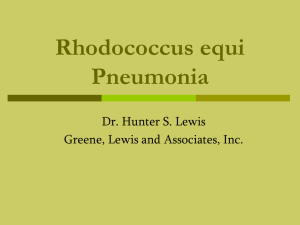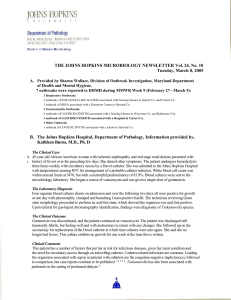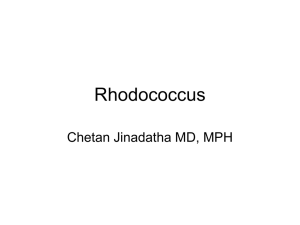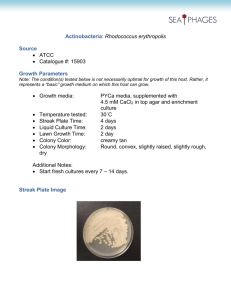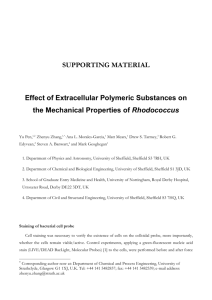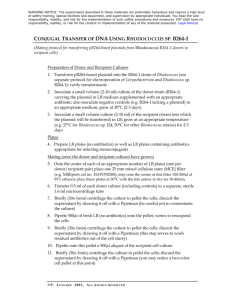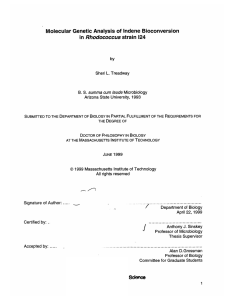Document
advertisement
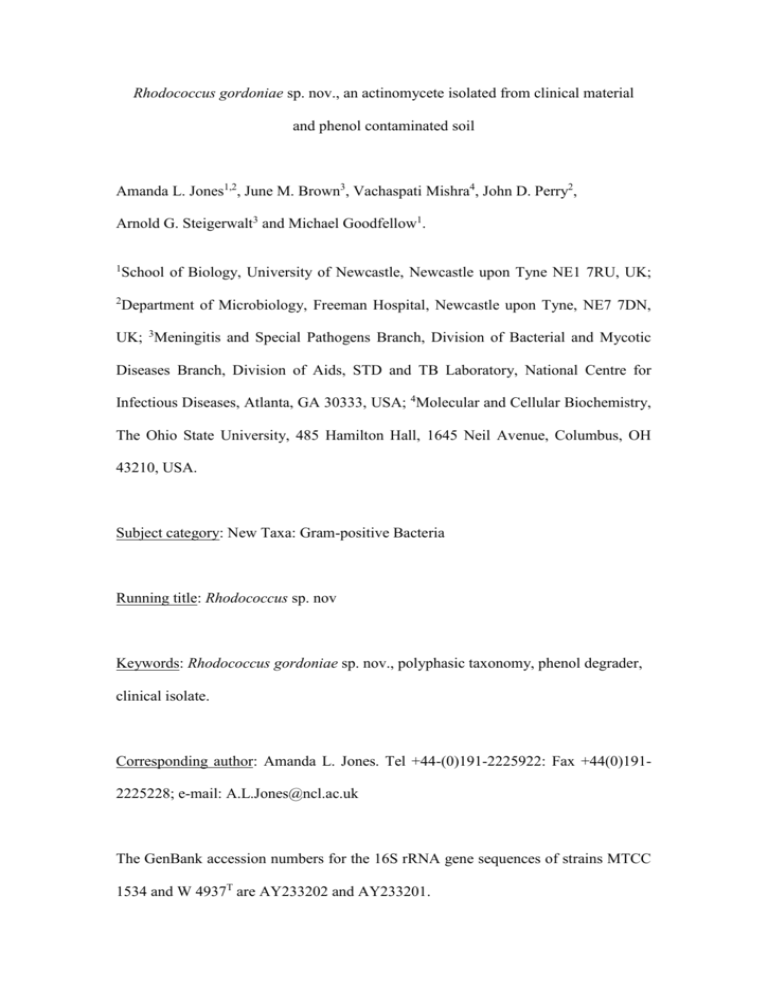
Rhodococcus gordoniae sp. nov., an actinomycete isolated from clinical material and phenol contaminated soil Amanda L. Jones1,2, June M. Brown3, Vachaspati Mishra4, John D. Perry2, Arnold G. Steigerwalt3 and Michael Goodfellow1. 1 School of Biology, University of Newcastle, Newcastle upon Tyne NE1 7RU, UK; 2 Department of Microbiology, Freeman Hospital, Newcastle upon Tyne, NE7 7DN, UK; 3Meningitis and Special Pathogens Branch, Division of Bacterial and Mycotic Diseases Branch, Division of Aids, STD and TB Laboratory, National Centre for Infectious Diseases, Atlanta, GA 30333, USA; 4Molecular and Cellular Biochemistry, The Ohio State University, 485 Hamilton Hall, 1645 Neil Avenue, Columbus, OH 43210, USA. Subject category: New Taxa: Gram-positive Bacteria Running title: Rhodococcus sp. nov Keywords: Rhodococcus gordoniae sp. nov., polyphasic taxonomy, phenol degrader, clinical isolate. Corresponding author: Amanda L. Jones. Tel +44-(0)191-2225922: Fax +44(0)1912225228; e-mail: A.L.Jones@ncl.ac.uk The GenBank accession numbers for the 16S rRNA gene sequences of strains MTCC 1534 and W 4937T are AY233202 and AY233201. ABSTRACT The taxonomic relationships of two actinomycetes provisionally assigned to the genus Rhodococcus were determined using a polyphasic taxonomic approach. The generic assignment was confirmed by 16S rRNA gene similarity data as the organisms, strains 1534 and W 4937T, were shown to belong to the Rhodococcus rhodochrous subclade. These organisms had phenotypic properties typical of rhodococci as they were aerobic, Gram-positive, weakly acid-fast actinomycetes which showed an elementary branching-rod-coccus growth cycle and contained meso-diaminopimelic acid, arabinose and galactose in whole-organism hydrolysates, N-glycolated muramic acid residues, dehydrogenated menaquinones with eight isoprene units as the predominant isoprenologue, and mycolic acids that co-migrated with those extracted from the type strain of Rhodococcus rhodochrous. The strains had identical phenotypic profiles and belong to the same genomic species, albeit one distinguished from Rhodococcus pyridinivorans with which they formed a distinct phyletic line. They were also distinguished from representatives of all of the species classified in the R. rhodochrous 16S rRNA gene tree using a set of phenotypic features. The genotypic and phenotypic data show that the strains merit recognition as a new species of Rhodococcus. The name proposed for the new species is Rhodococcus gordoniae, the type strain is W 4937T (= DSM 44689T = NCTC 13296T). The application of polyphasic procedures led to marked improvements in the classification of Rhodococcus and related genera (Goodfellow et al., 1998, 1999). The taxonomic status of validly described rhodococcal species is underpinned by a wealth of genotypic and phenotypic data (Goodfellow et al., 2002, 2003; Takeuchi et al., 2002; Zhang et al., 2002); representatives of these taxa can be assigned to four 2 subclades in the 16S rRNA Rhodococcus gene tree (Rainey et al., 1995; McMinn et al., 2000; Goodfellow et al., 2003). The improved classification of the genus provides a sound framework for the recognition of additional Rhodococcus species, including ones of clinical and industrial significance. Rhodococci show remarkable metabolic diversity, as exemplified by their ability to transform nitriles (Bunch, 1998) and degrade xenobiotic compounds (Dabbs, 1998; Goodfellow et al., 2003). In contrast, Rhodococcus equi strains cause infections in humans, notably in immunocompromised hosts (Kedlaya et al., 2001; Weinstock & Brown, 2002) though there are a few reports of infections caused by members of other Rhodococcus species (Spark et al., 1993; Cuello et al., 2002). The present polyphasic study was designed to determine the taxonomic position of strains MTCC 1534 and W 4937T. Isolate W 4937T had been distinguished from representatives of Rhodococcus species using phenotypic and ribotyping data (Spark et al., 1993). The two organisms were found to form a new species of Rhodococcus for which the name Rhodococcus gordoniae sp. nov. is proposed with organism W 4937T as the type strain. Strain MTCC (Microbial Type Culture Collection, Chandigarh, India) 1534 was isolated on M3 agar (Rowbotham & Cross, 1977) which had been inoculated with a suspension of phenol contaminated soil from near Chandigarh, India and incubated at 28°C for 4 days and strain W 4937T from a blood culture of an immunocompetent patient with fatal pneumonia associated with adult respiratory disease syndrome, as described previously (Spark et al., 1993). The organisms were maintained on glucose 3 yeast extract agar (GYEA; Gordon & Mihm, 1962) at room termperature and as glycerol suspensions (20%, v/v) at -20°C. The organisms and appropriate marker strains were examined for a range of phenotypic properties (Table 1) using standard procedures (Goodfellow et al., 1990). Biomass for the chemotaxonomic studies was prepared following growth of the isolates in shake flasks of GYE broth for 5 days at 28°C; after checking for purity the biomass was harvested by centrifugation, washed twice in distilled water and freezedried. Established HPLC and TLC procedures were used to determine the diagnostic isomers of diaminopimelic acid (A2pm; Staneck & Roberts, 1974), major wholeorganism sugars (Schaal, 1985), predominant isoprenoid quinones (Collins, 1994) and muramic acid type (Uchida et al., 1999). The alkaline methanolysis procedure was used to detect mycolic acids (Minnikin et al., 1980). Genomic DNA was isolated, purified and sequenced after Kim et al. (1998). The resultant 16S rRNA gene sequences of strains MTCC 1534 and W 4937T were aligned manually with corresponding sequences of representatives of the genera classified in the family Corynebacterineae, retrieved from the DDBJ, EMBL and GenBank databases, by using the AL 16S program (Chun, 1995). Evolutionary trees were inferred using the least-squares (Fitch & Margoliash, 1967) and neighbour-joining (Saitou & Nei, 1987) treeing algorithms from the PHYLIP suite of programs (Felsenstein, 1993). Evolution distance matrices for the least-squares and neighbourjoining methods were prepared after Jukes and Cantor (1969). The topologies of the resultant trees were evaluated by bootstrap analyses (Felsenstein, 1985) of the 4 neighbour-joining data based on 1,000 resamplings using the SEQBOOT and CONSENSE programs from the PHYLIP package. Chromosomal DNA for the DNA-DNA hybridization studies was extracted from strains 1534 and W 4937T and the type strain of R. pyridinivorans following growth in trypticase soy broth for 3 days at 35°C and purification using universal bacterial DNA isolation procedures modified for Gram-positive bacteria that produce copious amounts of exopolysaccharides or capsular material by the addition of hexadecyltrimethylammonia bromide (Graves & Swaminathan, 1993). Repeat extractions were performed with 20% (w/v) SDS to improve the DNA yield as adapted from Loeffelholz & Scholl (1989). DNA:DNA relatedness studies between the test strains and R. pyridinivorans KCTC 0647BPT were carried out using a hydroxyapatite procedure (Brenner et al., 1982). Almost complete 16S rRNA gene sequences were obtained for strains MTCC 1534 and W 4937T; comparison of these sequences with corresponding data from representatives of the suborder Corynebacterineae confirmed that they belong to the genus Rhodococcus (data not shown). Similarly, the results of the chemotaxonomic and morphological studies, as given in the species description, are consistent with the assignment of the strains to this genus (Goodfellow et al., 1998). It is evident from Figure 1 that the tested strains belong to the R. rhodochrous 16S rDNA subclade (Rainey et al., 1995; McMinn et al., 2000; Goodfellow et al., 2003), a relationship that is supported by the results with all three treeing algorithms, by a high bootstrap value in the neighbour-joining analysis and by the high 16S rRNA gene 5 similarities found between members of R. rhodochrous subclade and strains MTCC 1534 and W 4937T (96.9 – 99.1%). Strains MTCC 1534 and W9437T shared a 16S rDNA nucleotide (nt) similarity of 99.9%, a value which corresponds to 2 nt differences at 1421 locations and are most closely related to R. pyridinivorans PDB9T and R. rhodochrous DSM 43274T. The test strains showed 16S rDNA nt similarities with the R. pyridinivorans strain of 99.1 and 98.8% respectively, values which correspond to 13 and 15 nt differences at 1403 sites; the corresponding values with the R. rhodochrous strain were 99.0% and 99.1%, values equivalent to 12 and 14 nt, respectively. It is also evident from Figure 1 that R. rhodochrous DSM 43274T, formerly R. roseus Tsukamura et al. 1991, is more closely related to R. pyridinivorans PDB9T (99.7% similarity, 5 nucleotide differences) than to R. rhodochrous DSM 43241T (99.2% similarity, 12 nucleotide differences). These data suggest that strain DSM 43274T should be reclassified as R. pyridinivorans though comparative studies with the type strain of this species are need to prove the point. 16S rDNA similarity values between 99.0 and 99.5% values have been reported for representatives of several validly described species of Rhodococcus (Yoon et al., 2000; Goodfellow et al., 2002, 2003) that share DNA:DNA relatedness values well below the 70% cut-off point recommended for the delineation of bacterial species (Wayne et al., 1987). Strains MTCC 1534 and W 4937T shared a DNA:DNA relatedness value of 100% and showed a corresponding value of 60% with the type strain of R. pyridinivorans; results which show that the test strains form a distinct genomic species. It is evident from Table 1 that strains MTCC 1534 and W 4937T gave an identical phenotypic profile which separates them from representatives of species classified in the R. rhodochrous 16S rDNA subclade. 6 The present study shows that strains MTCC 1534 and W 4937T have properties consistent with their assignment to the same species in the genus Rhodococcus. They are particularly closely related to R. pyridinivorans and R. rhodochrous but can be distinguished from these species using genotypic and phenotypic data. It is proposed that these organisms be assigned to the genus Rhodococcus as Rhodococcus gordoniae sp. nov. The description of the type strain W 4937T (= DSM 44689T = NCTC 13296T) and strain MTCC 1534 is given below. Description of Rhodococcus gordoniae sp. nov. Rhodococcus gordoniae (gor’d.on.iae. N.L. gen.n. gordoniae, of Gordon, named after Ruth Gordon a celebrated microbial systematist). The description is based upon information taken from this study and from Spark et al. (1993). Aerobic, Gram-positive, catalase-positive actinomycete which forms branched filaments that fragment into coccobacillary elements. Acid-fast when grown on 7H10 agar and stained using the modified Kinyoun procedure. Neither aerial hyphae nor diffusible pigments are formed. Produces raised, shiny, pink to coral pigmented colonies with filamentous edges on blood and chocolate agar plates incubated at 36°C. Grows on MacConkey agar supplemented with crystal violet; grows poorly on Lowenstein-Jensen medium with 5%, w/v sodium chloride. Degrades tyrosine but not casein, hypoxanthine or xanthine. Hydrolyses aesculin weakly and is indole and urease negative. Hydrogen sulphide is not produced. Reduces nitrate to nitrite and grows in the presence of lysozyme. Does not exhibit equi-factors. Acid is produced 7 from L-arabinose, D-fructose, D-galactose, D-glucose, glycerol, D-mannitol, Dmannose, salicin, D-sorbitol, D-sucrose, D-trehalose and D-xylose, but not from Dcellobiose, inositol, D-maltose or L-rhamnose. Resistant to clindamycin and norfloxacin but susceptible to amikacin, amoxicillin-clavulate, ampicillin, ampicillinsulbactam, cephalothin, cefotaxime, ceftriaxone, ciprofloxacin, doxycycline, erythromycin, gentamicin, imipenem, minocycline, oxacillin, penicillin, rifampin, sulfamethoxazole, tetracycline, trimethoprin – sulfamethoxazole and vancomycin. Additional phenotypic properties are shown in Table 1. The organism is characterised by the presence of meso-A2pm, arabinose and galactose in whole-organism hydrolysates, contains N-glycolated muramic acid residues, predominant proportions of dehydrogenated menaquinones with eight isoprene units and mycolic acids that comigrate with those of the type strain of R. rhodochrous. The type strain (W 4937T) was isolated from the blood culture of a previously healthy patient who died of pneumonia-associated adult respiratory distress syndrome. Strain MTCC 1534 (= DSM 44690), which is clearly very closely related to strain W 4937T, was isolated from a markedly different habitat, namely phenol-contaminated soil. This organism can degrade phenol as a sole carbon source at very high concentrations (>25mM) in a minimal medium (Mishra, V., pers. comm.). Acknowledgements Amanda Jones is grateful to the Freeman Hospital, Newcastle upon Tyne and the School of Biology, University of Newcastle upon Tyne for financial support. The authors are grateful to Dr Jean Euzéby for help in choosing the specific epithet. 8 References Brenner, D.J., McWhorter, A.C., Leete Knutson, J.K. & Steigerwalt, A.G. (1982). Escherichia vulneris: a new species of Enterobacteriaceae associated with human wounds. J Clin Microbiol 15, 1133-1140. Bunch, A.L. (1998). Biotransformation of nitriles by rhodococci. Antonie van Leeuwenhoek 74, 89-97. Chun, J. (1995). Computer-assisted Classification and Identification of Actinomycetes. Ph.D. thesis, University of Newcastle, Newcastle upon Tyne, UK. Collins, M.D. (1994). Isoprenoid quinones. In Chemical Methods in Prokaryotic Systematics, pp. 265-309. Edited by M. Goodfellow & A.G. O’Donnell. Chichester, John Wiley & Sons. Cuello, O.H., Caorlin, M.J., Revigho, V.E., Carvajal, L., Juarez, C.P., Palacio de Guerra, E. & Luna, J.D. (2002). Rhodococcus globerulus keratitis after laser in situ keratomileusis. J Cataract Refract Surg 28, 2235-2237. Dabbs, E.R. (1998). Cloning of genes that have environmental and clinical importance from rhodococci and related bacteria. Antonie van Leeuwenhoek 74, 155168. 9 Felsenstein, J. (1985). Confidence limits on phylogenies: an approach using the bootstrap. Evolution 39, 783-791. Felsenstein, J. (1993). PHYLIP (Phylogenetic Inference Package), version 3.5c Department of Genetics, University of Washington, Seattle, USA. Fitch, W.M. & Margoliash, E. (1967). Construction of phylogenetic trees: a method based on mutation distances as estimated from cytochrome c sequences is of general applicability. Science 155, 279-284. Goodfellow, M., Thomas, E.G., Ward, A.C. & James, A.L. (1990). Classification and identification of rhodococci. Zbl Bakt 274, 299-315. Goodfellow, M., Alderson, G. & Chun, J. (1998). Rhodococcal systematics: problems and developments. Antonie van Leeuwenhoek 74, 1-12. Goodfellow, M., Isik, K. & Yates, E. (1999). Actinomycete systematics: an unfinished synthesis. Nova Acta Leopold NF 80 312, 47-82. Goodfellow, M., Chun, J., Stackebrandt, E. & Kroppenstedt, R.M. (2002). Transfer of Tsukamurella wratislaviensis Goodfellow et al. 1995 to the genus Rhodococcus as Rhodococcus wratislaviensis comb. Int J Syst Evol Microbiol 52, 749-755. 10 Goodfellow, M., Jones, A.L., Maldonado, L.A. & Salanitro, J. (2003). Rhodococcus aetherovorans sp. nov., a new species of methyl t-butyl ether-degrading actinomycetes. Syst Appl Microbiol (in press). Gordon, R.E. & Mihm, J.M. (1962). Identification of Nocardia caviae nov. comb. Ann NY Acad Sci 98, 628-636. Graves, L.M. & Swaminathan, B. (1993). Universal bacterial DNA isolation procedure. In: Diagnostic Molecular Microbiology: Principles and Applications, pp. 617-621. Edited by D.H. Persing, T.F. Smith, F.C. Tenover, and T.J. White. Washington, D.C.: American Society for Microbiology. Jukes, T.H. & Cantor, C.R. (1969). Evolution of protein molecules. In: Mammalian Protein Metabolism, 3, pp. 21-132. Edited by H.N. Munro. New York, Academic Press. Kedlaya, I., Ing, M.B. & Wong, S.S. (2001). Rhodococcus equi infections in immunocompetent hosts: Case report and review. Clin Infect Dis 32, e39-e47. Kim, S.B., Falconer, C., Williams, E. & Goodfellow, M. (1998). Streptomyces thermocarboxydovorans sp. nov. and Streptomyces thermocarboxydus sp. nov., two moderately thermophilic carboxydotrophic species from soil. Int J Syst Bacteriol 48, 59-68. 11 Loeffelholz, M.J. & Scholl, D.R. (1989). Method for improved extraction of DNA from Nocardia asteroides. J Clin Microbiol 27, 1880-1881. McMinn, E.J., Alderson, G., Dodson, H.I., Goodfellow, M. & Ward, A.C. (2000). Genomic and phenomic differentiation of Rhodococcus equi and related strains. Antonie van Leeuwenhoek 78, 331-340. Minnikin, D.E., Hutchinson, I.G., Caldicott, A.B. & Goodfellow, M. (1980). Thinlayer chromatography of methanolysates of mycolic acid containing bacteria. J. Chromat 188, 221-233. Rainey, F.A., Burghardt, J., Kroppenstedt, R.M., Klatte, S. & Stackebrandt, E. (1995). Phylogenetic analysis of the genera Rhodococcus and Nocardia and evidence for the evolutionary origins of the genus Nocardia from within the radiation of Rhodococcus species. Microbiology 141, 523-528. Rowbotham, T.J. & Cross, T. (1977). Ecology of Rhodococcus coprophilus and associated actinomycetes in freshwater and agricultural habitats. J Gen Microbiol 100, 231-240. Saitou, N. & Nei, M. (1987). The neighbor-joining method: a new method for reconstructing phylogenetic trees. Mol Biol Evol 4, 406-425. Schaal, K.P. (1985). Identification of clinically significant actinomycetes and related bacteria using chemical techniques. In Chemical Methods in Bacterial Systematics, 12 pp. 359-381. Edited by M. Goodfellow & D.E. Minnikin. London: Academic Press Inc. Spark, R.P., McNeil, M.M., Brown, J.M., Lasker, B.A., Montano, M.A. & Garfield, M.D. (1993). Rhodococcus species fatal infection in an immunocompetent host. Arch Pathol Lab Med 117, 515-520. Staneck, J.L. & Roberts, G.D. (1974). Simplified approach to the identification of aerobic actinomycetes by thin-layer chromatography. Appl Microbiol 28, 226-231. Takeuchi, M., Hatano, K., Sedlácek, I. & Pácová, Z. (2002). Rhodococcus jostii sp. nov., isolated from a medieval grave. Int J Syst Evol Bacteriol 52, 409-413. Tsukamura, M., Yano, I., Kudo, T. & Miyama, A. (1991). Rhodococcus roseus sp. nov., nom. rev. Int J Syst Evol Bacteriol 41, 385-389. Uchida, K., Kudo, T., Suzuki, K. & Nakase, T. (1999). A new rapid method of glycolate test by diethyl ether extraction, which is applicable to a small amount of bacterial cells of less than one milligram. J Gen Appl Microbiol 45, 49-56. Wayne, L.G., Brenner, D.J., Colwell, R.R. & 9 other authors. (1987). International Committee on Systematic Bacteriology. Report of the ad hoc committee on reconciliation of approaches to bacterial systematics. Int J Syst Bacteriol 37, 463-464. 13 Weinstock, D.M. & Brown, A.E. (2002). Rhodococcus equi: An emerging pathogen. Clin Infect Dis 34, 1379-1385. Yoon, J-H., Kang, S-S., Cho, Y-G., Lee, S.T., Kho, Y.H., Kim, C-J. & Park, Y-H. (2000). Rhodococcus pyridinovorans sp. nov., a pyridine-degrading bacterium. Int J Syst Evol Microbiol 50, 2173-2180. Zhang, J., Zhang, Y., Xiao, C., Liu, Z. & Goodfellow, M. (2002). Rhodococcus maanshanensis sp. nov., a novel actinomycete from soil. Int J Syst Evol Microbiol 52, 2121-2126. 14 Figure legend Fig.1. Neighbour-joining tree (Saitou & Nei, 1987) based on nearly complete 16S rDNA sequences of strains MTCC 1534 and W 4937T showing their position in the R.. rhodochrous subclade. Asterisks indicate branches of the tree that were also found using the least-squares (Fitch & Margoliash, 1967) and maximum-parsimony (Kluge & Farris, 1969) algorithms. The numbers at the nodes indicate the levels of bootstrap support based on a neighbour-joining analysis of 1000 re-sampled datasets; only values above 50% are given. The scale bar indicates 0.02 substitutions per nucleotide position. T, type strain. 15 Table 1. Characteristics that distinguish strains MTCC 1534 and W 4937T from the type strains of species classified in the R. rhodochrous 16S rDNA subclade Organisms are identified as: 1, strains MTCC 1534 and W 4937T; 2, R. aetherovorans 10bc 312T; 3, R. coprophilus N 744T; 4, R. pyridinivorans KCTC 0647T; 5, R. rhodochrous N54T; 6, R. ruber N361T, 7, R. zopfii DSM 44108T Characters are scored as: +, positive; -, negative. 1 Morphogenetic sequencea EB-R-C 2 R-C 3 H-R-C 4 EB-R-C 5 EB-R-C 6 H-R-C 7 H-R-C Biochemical tests: Aesculin hydrolysis Urea hydrolysis Degradation tests: DNA Starch Uric acid - - + + + + + - + + + + - + - + + + - + + + + + + + Growth on sole carbon sources: At 1%, w/v Arbutin Glycerol Meso-inositol α-methyl-D-glucoside + - + - + + + - + + - + - + + + + At 0.1%, w/v m-Hydroxybenzoic acid p-Hydroxybenzoic acid Monoethanolamine Sodium benzoate Sodium butyrate Sodium gluconate + + + + + - + + + + + - - + + - + + + + + + + + + + + + + + + a EB-R-C, elementary branching-rod-coccus growth cycle; R-C, rod-coccus growth cycle; H-R-C, hypha-rod-coccus growth cycle. All of the strains reduce nitrate and grow on the following compounds as sole sources of carbon for energy and growth: acetamide, arabitol, cellobiose, ethanol, fructose, galactose, glucose, maltose, mannitol, mannose, melezitose, ribose, salicin, sorbitol, sucrose, trehalose, xylitol (at 1%, w/v), hydroxybutyric acid, L-leucine, sodium acetate, sodium fumarate, sodium pyruvate and sodium succinate (at 0.1%, w/v) but not on adonitol or dulcitol (at 1.0%, w/v).

